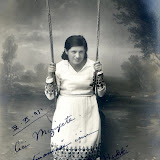Postcards of women at the birth of the Turkish Republic
That is no country for old men.
W B Yeats; Sailing to Byzantium
The case can be made that the people who gained the most from Kemal Ataturk’s revolution were educated, middle class women. Men had certain rights expanded. Women actually got some; the vote (1934), legal equality and access to positions in government. As Turks will point out, they had more rights than their sisters in several Western Europe countries. So, what happened? Indexes measuring women’s rights around the world commonly rate Turkey down among underdeveloped states like Sudan. Is this really the pervading influence of Islam at work, or is something more ingrained in the culture? And incidentally, how was it that the two countries that initiated the first great modernist revolutions in the 20th century, Turkey and Russia, ended up looking outdated so quickly? Every time an honour killing is reported in the international press or statistics on the popularity of Islamism are produced, commentators not bound by diplomatic niceties talk about the country joining the 21st century before it can join Europe.
The women in this gallery sat for their portraits during the era surrounding Ataturk’s revolution. They voted and they had other opportunities denied to their mothers. They could have been employed in government offices, which is a big step considering that a few years earlier many women lived indoors. Embracing secularism has never meant abandoning religion and several in the gallery obviously haven’t. Not all of them are necessarily Turkish; they could be Greek, Jewish or Armenian. The most interesting women here appear to have not only spurned religion but also the whole classical idea of womanhood.
At first glance the portraits of this last group of women suggests a subculture of lesbian cross-dressing. It’s hard to know what to make of this. On the one hand, lesbian and cross dressing subcultures existed in Berlin, Paris and London and in certain ways Istanbul (still called Constantinople back then) was more self-consciously European than it is now. Still, if it was here it has been erased from history books. Even contemporary Turkish feminists confess ignorance of any such subculture. On the other hand, it’s the nature of collecting to be selective. It’s hard to pass up an old photograph of a woman in man’s clothes even if the explanation turns out tamer than the image implies. So, are these photographs evidence of something more interesting and subversive taking place in Turkey than we are likely to find in the usual memoirs and reflections? We can only hope so.
Right now Turkey is locked in a fight more intriguing than a wrestling match between two blind men. On one side are the pious Islamists insisting that an Islamic state can be democratic (a glance beyond the borders suggests otherwise). Opposing them, (we are talking about the edges here, not the morass in the middle) hard line secularists argue the only way to protect the ideals of 1923 is to return to them. Turkey watchers (Surely there’s a better term.) agree; it’s too early to take bets on the outcome but, although the Islamists reject Darwin’s theory, history favours evolution. The further the country moves away from 1923, the more desperate and outdated the hard line secularists’ arguments sound. The commentators may not grasp the paradox but if they want Turkey to join their 21st century it will necessarily involve religion being admitted to the fold at some level.
The futures that pious Islamists and hard line secularists offer Turkey begin to look similar. In both cases it is a rigidly controlled culture dominated by Orwellian double-speak; “faith is freedom” or “the future is the past”. Both reason that if the basic human right to believe what you want didn’t exist people wouldn’t want it. Both are boys’ clubs that see women’s rights as insignificant in the grand scheme. Neither wants progress, merely power. What would their grandmothers think?
Some of the images in this post can be found in an exhibition of cross-dressers at Luminous Lint. To view that exhibition, go HERE.
 |
| POSTCARDS FROM THE EDGE |






No comments:
Post a Comment
Add comments here